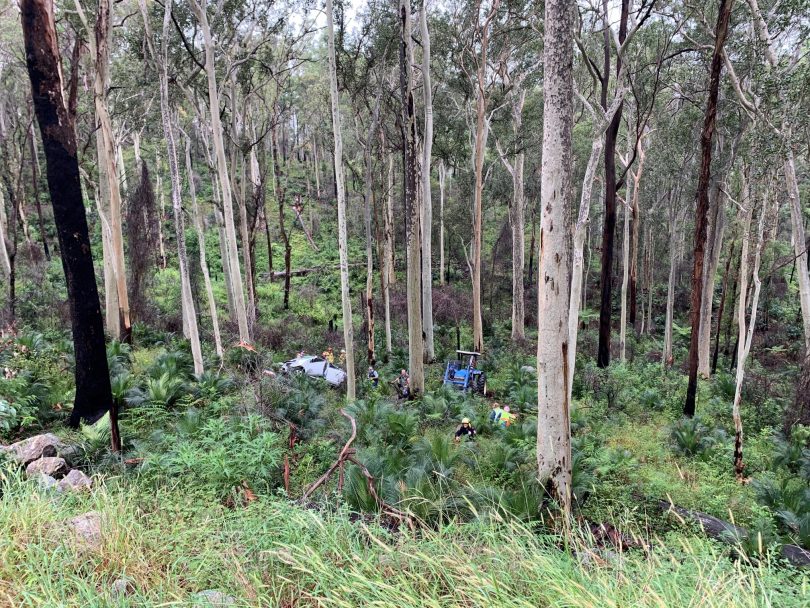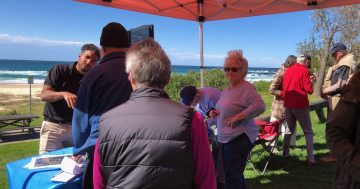
A woman died after her car crashed down an embankment at Currowan on Sunday, 31 January. Photo: South Coast Police District Facebook.
The recent death of a woman after her car crashed near Clyde Mountain has reignited calls to improve mobile phone coverage on Kings Highway. Renewed questions are being asked about why a funded phone tower has not yet been built on the mountain.
NSW Police said on Sunday, 31 January, a 68-year-old woman was travelling east on Kings Highway at Currowan when her Toyota Prius crashed 12 metres down an embankment. Police said she was airlifted to Canberra Hospital with serious injuries, but died there on Monday.
The tragedy was compounded when passing motorists ignored a nearby resident who discovered the woman in her crashed car. The crash site is in a mobile black spot, and she was trying to get their assistance to call for help from emergency services.
Telstra’s online 4G coverage map shows there is no mobile reception on Kings Highway roughly between Monga to the west and Nelligen Creek to the east.
Michele Edwards, a business owner from Batemans Bay, has been campaigning for improved mobile reception across Clyde Mountain for the past five years after her son crashed while driving his car on the highway and had to walk 2km and climb a tree to find reception to call for help.

This map shows the coverage of Telstra’s 4G network, highlighting a lack of coverage in the section of Kings Highway roughly between Monga to the west and Nelligen Creek to the east. Image: Telstra.
“I don’t want to see our local families continue to suffer like this,” she said. “It’s 2021 now and we don’t have mobile reception on that highway.
“It’s one thing to introduce a mobile black spot funding program, but if it’s not getting used then what’s the use?”
Michele was referring to the Federal Government’s $380 million Mobile Black Spot Program, which was created to invest in telecommunications infrastructure to improve mobile coverage and competition across Australia.
In April 2018, the Federal Government provided $60 million for 125 ‘specific priority locations’ where base stations were needed to overcome black spots. Clyde Mountain came in at number five on the priority list.
In July 2020, a spokesperson for the Department of Infrastructure, Transport, Regional Development and Communications told Region Media the mountain’s base station was expected to be built by the end of 2020.
But as of February 2021 the base station has still not been built.
“Work has started, and we are aiming to have the project completed by the end of March, however this timeline will be dependent on the arrival of critical equipment from overseas,” said a Telstra spokesperson.
On Wednesday, 3 February, Member for Gilmore Fiona Phillips said after Sunday’s tragic crash she raised concerns about the black spot directly with Minister for Communications Paul Fletcher about the progress of this base station.
“Our community has been fighting to fix the mobile phone black spot on Clyde Mountain for years, but what we have seen from the government is delays and excuses for why these concerns aren’t being taken seriously,” said Ms Phillips.
“These delays are putting lives at risk and the minister must provide urgent assurances to our community that this site will be completed as is currently planned. We cannot afford to wait any longer.”
A Department of Infrastructure, Transport, Regional Development and Communications spokesperson said the Clyde Mountain base station initially experienced delays due to Telstra being unable to obtain property and planning approvals at a suitable site, and subsequently being unable to gain safe access to the area following the impact of the Black Summer bushfires.
The spokesperson confirmed construction of the base station has begun, with the final commissioning and switch-on dependent on delivery of radio transmission equipment from overseas, which has been delayed as a result of COVID-19 and is now expected to arrive in March.
“Subject to receiving the radio transmission equipment by the end of March, Telstra expects the base station to go live shortly thereafter,” they said.
Ms Edwards said most of the complaints about the lack of reception on Kings Highway are from ambulance workers, tow truck drivers and fire service personnel.
“They are so frustrated they are still dealing with the issue,” she said. “People are dying because of it.”








